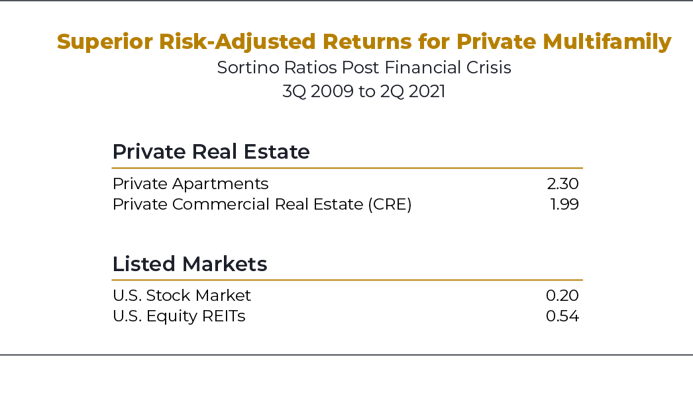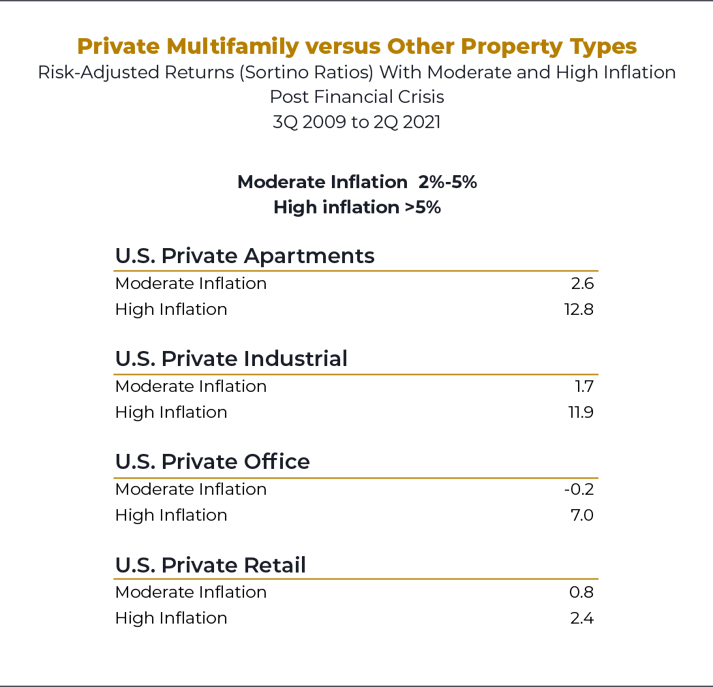Our posts to this point have centered on utilizing the third largest asset class (real estate) to gain broader diversification to potentially counterbalance the increasing and corrosive impact of inflation on client portfolios. To support this, we highlighted how commercial real estate and multifamily properties have historically outperformed many traditional, inflation-hedging strategies during different inflationary periods.
In this discussion, we provide “the numbers” to better understand why multifamily properties are generally more sensitive—in a good way—to inflation than other property types. To illustrate the advantage of multifamily apartments over other real estate asset classes, we turn to groundbreaking research conducted by Berkadia, a national leader in commercial real estate servicing and financing.
In its recent landmark study, A Better Way to Assess Inflation and Risk in Real Estate (2021), Berkadia examined the inflation sensitivity and risk-adjusted returns of private real estate, listed REITs, and stocks. Their conclusions were striking.
When Inflation Provides Upside
Berkadia illustrated how various types of real estate respond to inflation by calculating “inflation beta.” As investment professionals, we are very familiar with beta as a measure of market sensitivity. For example, an equity index fund may have a market beta of 1, since it is designed to move in tandem with the equity markets. “Inflation beta” shows how sensitive an investment is to inflation.

“Post GFC [Great Financial Crisis], a 1% rise in inflation implies a 1.20% rise in private CRE excess returns. Conversely, over the same period, a 1% rise in inflation implies a decline in the returns of REITs and stocks.”
- Berkadia Research
Private Multifamily Risk-Adjusted Returns
Next, Berkadia examined risk-adjusted returns. Berkadia calculated excess return per unit of downside risk using the Sortino Ratio, another highly useful measure of performance, because most investors experience “loss aversion” (losses tend to have higher negative emotional intensity than positive feelings of equal gains). This suggests downside protection is as important—if not more important—to client portfolios.
Thus, the Sortino Ratio can provide a more insightful measure of risk-adjusted returns, calculating excess returns per unit of downside risk.
 “U.S. private CRE risk-adjusted returns tend to be larger during times of high inflation.”
“U.S. private CRE risk-adjusted returns tend to be larger during times of high inflation.”
- Berkadia Research
Multifamily Leads Amidst Moderate and High Inflation
Finally, Berkadia examined how different types of private real estate performed against recent inflationary backdrops. Private apartments outperformed on a risk-adjusted basis.

“U.S. private apartments have the strongest risk-adjusted performance during both times of moderate and high inflation.”
- Berkadia Research
Taking Action
Helping to protect your client’s investment portfolios from today’s high and persistent inflation likely means you will need to seriously consider increasing allocations to new investment strategies. Commercial real estate has proven to perform well during inflationary episodes compared to traditional asset classes.
And as Berkadia’s new research reveals, when considering commercial real estate as a potential inflation-hedging asset class, multifamily apartments may be the optimal property type for investing.
If you’d like to learn more about the multifamily investment option, download our FREE eBook, A Potential Inflation Hedge for Today: Private Multifamily Real Estate.
You can also conveniently schedule a one-on-one meeting with me HERE.
Download Our Latest Ebook!
Topics: Insights, Inflation, Multifamily
The contents of this communication: (i) do not constitute an offer of securities or a solicitation of an offer to buy securities, (ii) offers can be made only by the confidential Private Placement Memorandum (the “PPM”) which is available upon request, (iii) do not and cannot replace the PPM and is qualified in its entirety by the PPM, and (iv) may not be relied upon in making an investment decision related to any investment offering by the issuer, or any affiliate, or partner thereof ("Issuer"). All potential investors must read the PPM and no person may invest without acknowledging receipt and complete review of the PPM. With respect to any “targeted” goals and performance levels outlined herein, these do not constitute a promise of performance, nor is there any assurance that the investment objectives of any program will be attained. All investments carry the risk of loss of some or all of the principal invested. These “targeted” factors are based upon reasonable assumptions more fully outlined in the Offering Documents/ PPM for the respective offering. Consult the PPM for investment conditions, risk factors, minimum requirements, fees and expenses and other pertinent information with respect to any investment. These investment opportunities have not been registered under the Securities Act of 1933 and are being offered pursuant to an exemption therefrom and from applicable state securities laws. All offerings are intended only for accredited investors unless otherwise specified. Past performance are no guarantee of future results. All information is subject to change. You should always consult a tax professional prior to investing. Investment offerings and investment decisions may only be made on the basis of a confidential private placement memorandum issued by Issuer, or one of its partner/issuers. Issuer does not warrant the accuracy or completeness of the information contained herein. Thank you for your cooperation.
Securities offered through Emerson Equity LLC Member: FINRA/SIPC. Only available in states where Emerson Equity LLC is registered. Emerson Equity LLC is not affiliated with any other entities identified in this communication.
Real Estate Risk Disclosure | 1031 Risk Disclosure
• There is no guarantee that any strategy will be successful or achieve investment objectives including, among other things, profits, distributions, tax benefits, exit strategy, etc.;
• Potential for property value loss – All real estate investments have the potential to lose value during the life of the investments;
• Change of tax status – The income stream and depreciation schedule for any investment property may affect the property owner’s income bracket and/or tax status. An unfavorable tax ruling may cancel deferral of capital gains and result in immediate tax liabilities;
• Potential for foreclosure – All financed real estate investments have potential for foreclosure;
• Illiquidity – These assets are commonly offered through private placement offerings and are illiquid securities. Because 1031 exchanges are commonly offered through private placement offerings and are illiquid securities. There is no secondary market for these investments.
•Reduction or Elimination of Monthly Cash Flow Distributions – Like any investment in real estate, if a property unexpectedly loses tenants or sustains substantial damage, there is potential for suspension of cash flow distributions;
• Impact of fees/expenses – Costs associated with the transaction may impact investors’ returns and may outweigh the tax benefits
• Stated tax benefits – Any stated tax benefits are not guaranteed and are subject to changes in the tax code. Speak to your tax professional prior to investing.
BrokerCheck Information:
• Check the background of this firm on FINRA's BrokerCheck.
• Check the background of this investment professional on FINRA's BrokerCheck.
